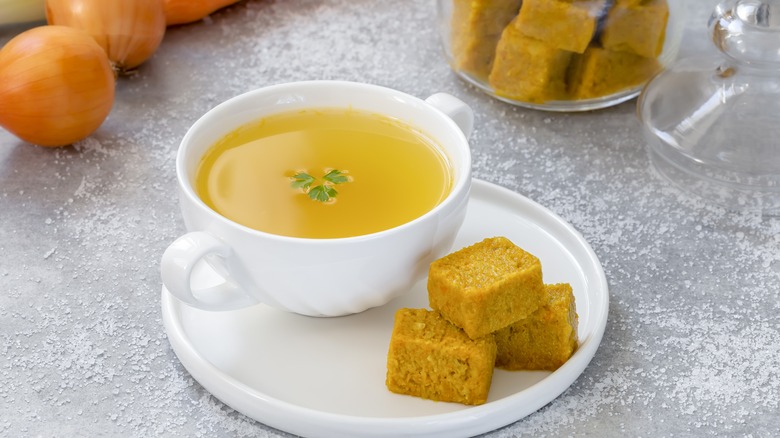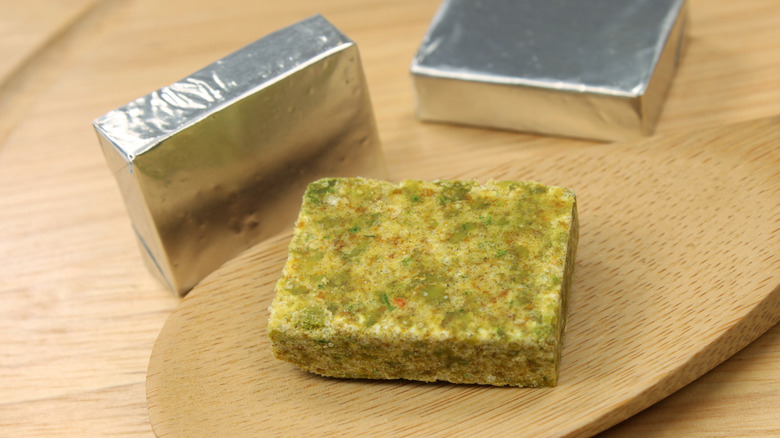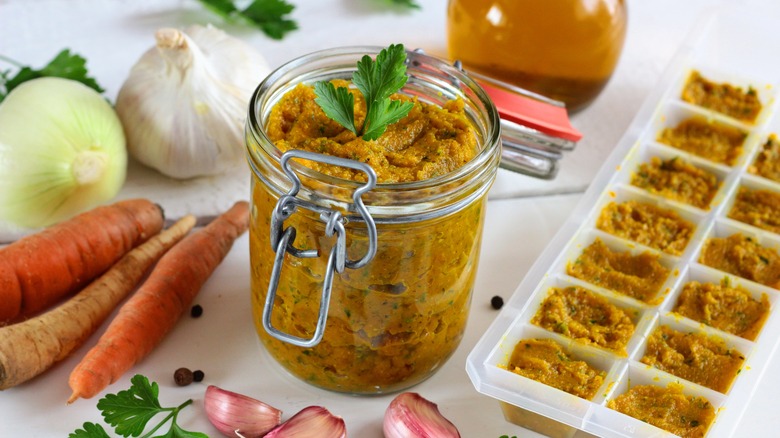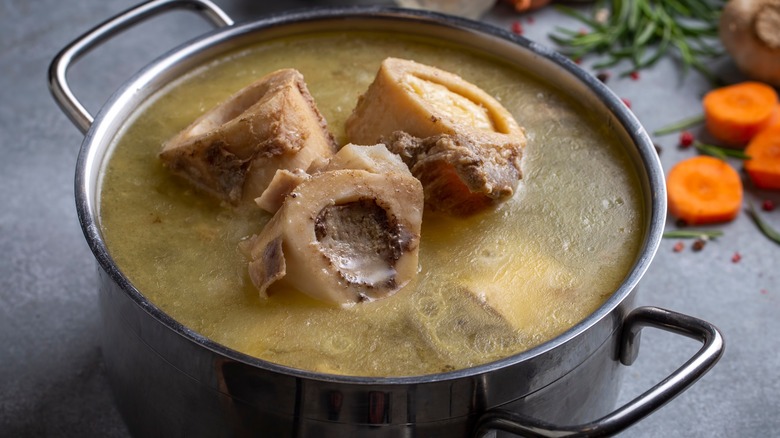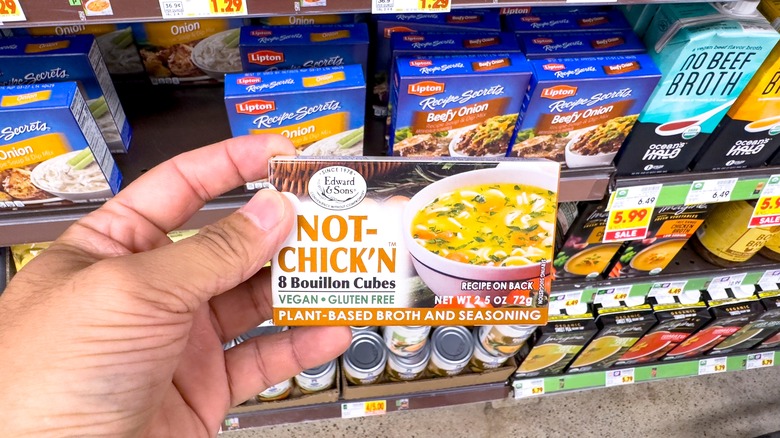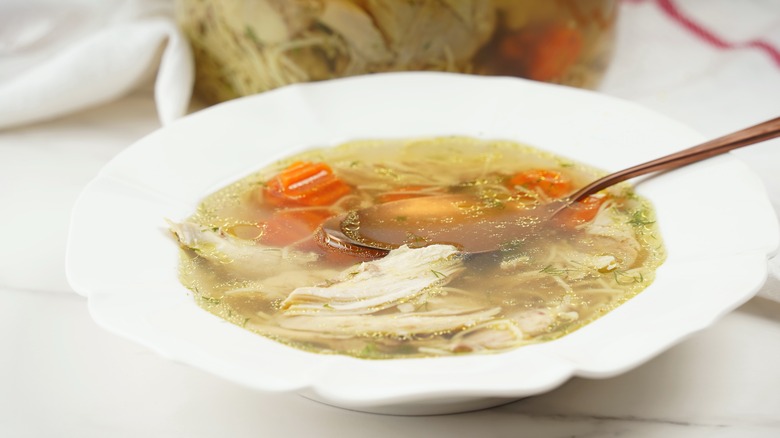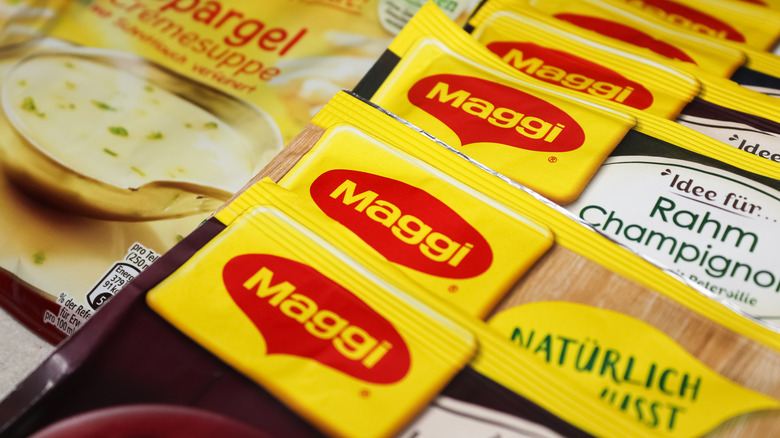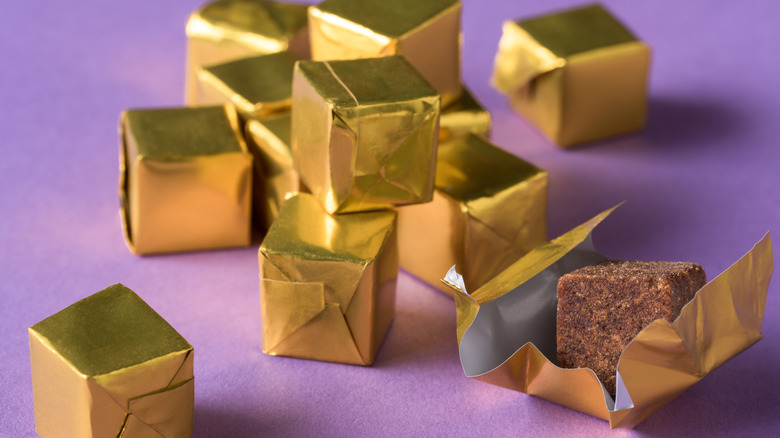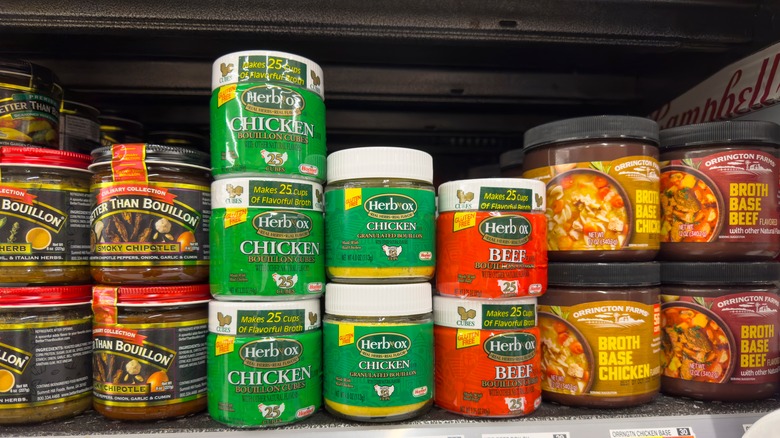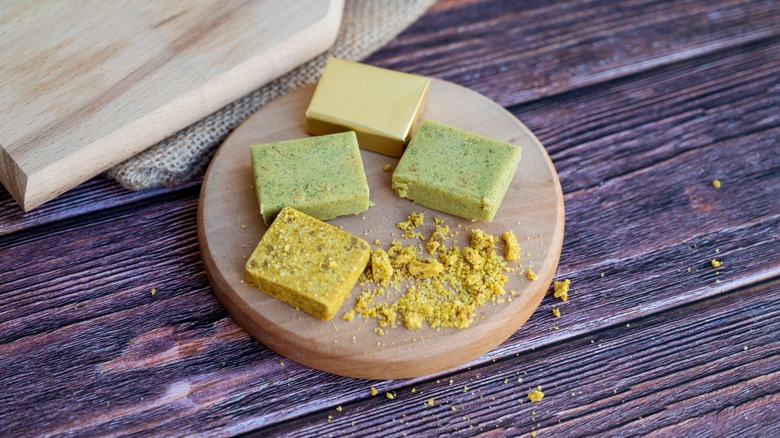What Bouillon Cubes Are Actually Made Of
We may receive a commission on purchases made from links.
Bouillon cubes are loaded with salty, umami flavor and have been adorning pantry shelves for almost a century. These crumbly little blocks are made from dehydrated meat stock or vegetable broth and added seasonings turning them into flavor powerhouses. They are typically added to casseroles, stews, or curries to amp up the taste.
Usually sold in individual foil packs, bouillon cubes are the ultimate cooking aid and offer a huge amount of flavor for a small cost and a low amount of storage space. As water is the best way to cook this food, you get serious bang for your buck when it comes to volume. Due to the convenience factor and the intense flavor that dehydrated stock produces, bouillon cubes are popular all over the world and across different world cuisines. We've got the deep dive on these incredibly versatile seasoning cubes for you, from everything to how to cook with them, how they're made to their nutritional information. Read on for everything you need to know about bouillon cubes.
What are bouillon cubes?
Bouillon cubes take their name from the French word for broth, which is related to an even older French word for boil. Before the invention of bouillon cubes, people had to boil bones or vegetables for several hours to extract the flavors and nutrients and arrive at a delicious, clear soup. Bouillon cubes are a shortcut to the brothy flavors that a long-boil achieves and contain powdered meat that has been boiled down and evaporated to condense and intensify the flavors. You can also buy vegetable bouillon cubes made from dehydrated vegetable powders, like celery and shitake mushrooms, and seasoned with synthetic flavor enhancers.
Bouillon cubes were first invented in Switzerland at the start of the 20th century. The first creator, Julius Maggi, launched an instant soup powder that he had designed himself. The Maggi brand of bouillon cubes is still in circulation and is commonly used in African and Indian cuisine. Other companies, such as the British firm OXO and German company Knorr, sprung up not long after this and still dominate the bouillon cube industry today.
How are bouillon cubes made?
Grocery store bouillon cubes are ultra-processed, meaning use some industrial ingredients and are made in a factory. Producers use dehydrated meat fat to give the bouillon cubes flavor — the most common proteins used are chicken, beef, and lamb, although you can also buy pork and seafood bouillon. Salt and oil are added for extra flavor, as well as maltodextrin to help the cubes dissolve in water. Some bouillon cubes also contain monosodium glutamate, or MSG, which brings a distinctive umami flavor to the stock.
MSG is a naturally occurring amino acid and is present in a wide variety of foods. Processed MSG, commonly used in bouillon cubes and instant noodle flavor packets, is a fermented version. Although MSG has been associated with some health conditions, learning everything you need to know about MSG is pretty complicated, with many dieticians and health professionals arguing that it is perfectly safe. No-MSG bouillon cubes exist if you'd rather avoid it.
You can also make your bouillon cubes at home by boiling a bone broth, manually dehydrating it to a paste, then chilling it in an ice cube tray to turn it into blocks. However, unlike store-bought bouillon cubes with a long stable shelf-life, homemade bouillon cubes must be stored in the fridge and consumed within 5 days like fresh bone broth.
Bouillon cubes vs bone broth
Homemade bone broth — made by boiling bones for anywhere between 8-12 hours — generally has a milder flavor than broth made with bouillon cubes. One of the main reasons for this is that bouillon cubes contain a serious amount of added salt, much more than you're likely to add while cooking at home. Salt is one of the primary ingredients in bouillon cubes, and this — along with the addition of MSG and concentrated meat and vegetable powders — leads to them having a stronger, more recognizable flavor.
Bone broth will take on the bones' flavor, especially if you roast them first or brown them to add caramel hints. However, getting the same level of concentrated flavor from bones and vegetables alone can be difficult. Bone broth is also extremely time and energy-intensive, as it needs to cook for a long period and requires a lot of heat to keep the pot at a simmer.
However, many cooks prefer homemade bone broth as the strong bouillon cube flavor can overwhelm more delicate recipes that call for stock. Bone broth also contains collagen, which drains out of the bones when cooked and is not present in bouillon broth. Collagen gives broth a jelly-like consistency when cooled, whereas bouillon cubes remain a wet liquid. Collagen in bone broth is associated with numerous health benefits, like improved skin and joint health.
What do bouillon cubes taste like?
Dissolved in water, bouillon cubes have a rich and salty umami flavor, making them a delicious supporting ingredient in soups and stews. You can buy flavored cubes, such as chicken, beef, lamb, and vegetable varieties.
Beef and lamb bouillon cubes tend to have a deeper, slightly earthier flavor than chicken stock cubes, which have a cleaner, lighter taste. Seafood bouillon cubes meanwhile have a slightly fishy taste which makes them an excellent base for fish soups or shellfish stews and boils. Vegetable stock cubes have a slightly cleaner flavor with notes of celery, which is one of the primary seasonings.
Bouillon cubes also have a very slightly cheesy flavor, similar to nutritional yeast. This makes it a great addition to popcorn — one of the mistakes everyone makes when popping popcorn is sticking to plain salt instead of experimenting with other savory flavors.
How to cook with bouillon cubes
Bouillon cubes are so popular worldwide because they provide a handy cheat for all sorts of meals. You need one bouillon cube for around one cup of water to make a portion of bouillon stock. Boil the water in your kettle and pour it over the bouillon cube, stirring well to ensure it completely dissolves.
You can add a whole bouillon cube directly into soups, risottos, or casseroles as they cook on the stove. Again, make sure the food is hot when you add your bouillon cubes and stir gently to help it mix in. Although you don't need to sweat bouillon to release the flavor — as with other cooking bases such as mirepoix — you still need to give the cube enough time to melt into your stew.
Chicken bouillon cubes are a handy way to make a quick chicken and noodle soup or enhance a bowl of ramen. If you want to add even more umami flavor to your noodle broth, soy-marinated ramen eggs are the topping your ramen has been missing. Bouillon cubes and bouillon paste are also commonly used to make Nigerian jollof rice – an aromatic tomato and rice dish spiced with paprika and chilies. Meanwhile, bouillon is a common ingredient in South American cuisine when making enchilada sauce.
Where to buy bouillon cubes?
Bouillon cubes are sold in grocery stores all over the world and are usually found in the canned foods aisle near the soups or in the spice and oil section. Knorr, OXO, and Maggi are among the most common brands, with Knorr being one of the leading manufacturers in the U.S. Knorr bouillon cubes cost around $1 to 2.50 in stores like Walmart, Lidl, Kroger, and Target.
You can also buy Knorr bouillon cubes online from retailers like Amazon. Maggi's Caldo Sabor a Pollo chicken bouillon cubes are also available on Amazon and cost just over $10 for a pack of 24 tablets. The low cost per item and the fact that one bouillon cube can transform into a whole cup of tasty broth make these a great budget seasoning to keep in your pantry. You can bust them out when you're running low on fresh ingredients and make a mouthwatering soup with frozen veggies, or just use them to create homemade instant noodles.
Nutritional information about bouillon cubes
Bouillon cubes are low in calories and have trace amounts of some nutrients, like selenium, copper, and calcium. A cup of bouillon made from one cube generally contains 5 to 10 calories. Bouillon cubes also contain some fat, either from dehydrated animal products — like chicken or beef fat — or from added oils. Knorr vegetable bouillon cubes have palm fat and palm oil added to help them bind together into cubes and give them a soft and crumbly feel.
Fish and shrimp-based bouillon cubes also contain added vegetable fats to replace the presence of animal fat. Most bouillon brands contain high quantities of sodium, with Knorr listing its products as having more than 300% of the daily recommended sodium allowance.
While bouillon cubes can definitely be part of a healthy diet, if you're looking for a more nutrient-dense option, using bone broth or making stocks from scratch at home is a great alternative. Bone broths and vegetable broth draw the nutrients out of ingredients and concentrate them in the stock, giving you a high dose of vitamins and collagen from the bone marrow.
Varieties of bouillon cubes
Most bouillon cubes offer pure stock flavor and taste like the primary ingredient they are made with, such as chicken, beef, pork, or fish. However, you can also find bouillon products with other flavorings, such as Knorr's chicken and tomato bouillon base, making a delicious starter for chicken enchiladas. Tom Yam seasoning bouillon cubes are also made to flavor the Thai dish, Tom Yam soup, or it's added to Thai soups and curries. Tom Yam cubes have a shrimp base and contain tamarind, a common seasoning in Thai cuisine.
Knorr and other bouillon manufacturers also sell tins of bouillon powder that allow you to measure the quantities with a spoon rather than using a whole cube or breaking one into pieces. You can also find bouillon pastes, such as Better Than Bouillon, with a lower sodium content than bouillon cubes. Some brands, like Edward & Sons, produce gluten-free bouillon cubes and some varieties of vegetable bouillon cubes are suitable for vegans.
How to store bouillon cubes
One of the main appeals of bouillon cubes is how easy they are to store. Most varieties of bouillon cubes are either wrapped in individual foil packets or available in air-tight jars to help them stay fresh and prevent them from drying out. Bouillon cubes can last for around two years at room temperature and are one of those foods you actually don't have to refrigerate. This means that you can keep them in your cupboard and not feel pressured to use the whole packet within an immediate timeframe. This is a lot longer than an open carton of chicken stock can be stored.
To get the most shelf-life out of your bouillon cubes, make sure that you keep the lid tightly fixed on any jars or tubes containing bouillon products. If you unwrap the foil on a bouillon cube and only use part of it for cooking, fold the foil back around the remaining piece as tightly as possible to help retain freshness. You can also store opened bouillon cubes in the fridge to help them stay fresh, although the moisture in your cooler may start to degrade the block over time.
